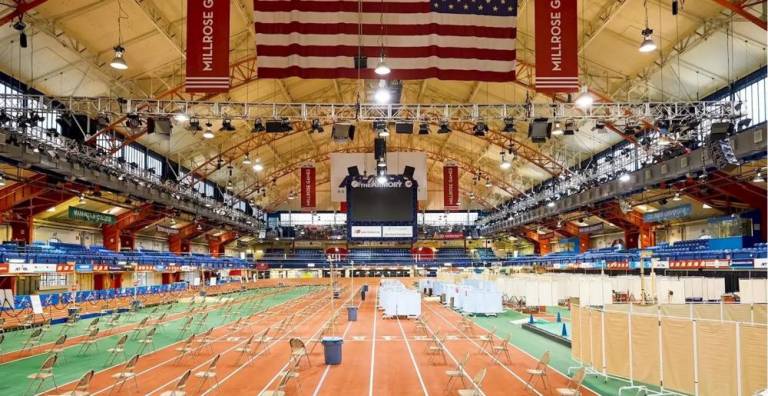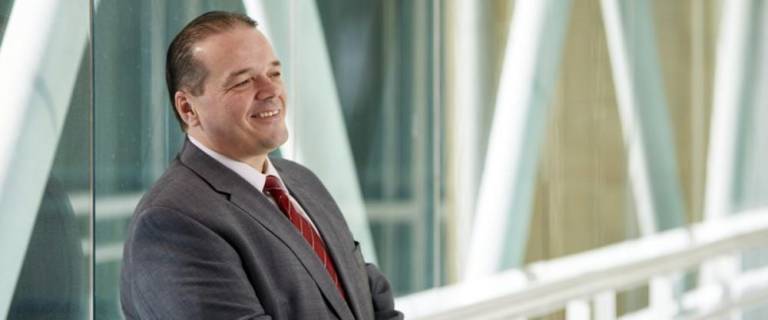Vaccine Drive at the Armory
A hospital director aims for civic equity and herd immunity in Northern Manhattan


Andres Nieto has a rallying cry for these hard times.
“We want to achieve heard immunity in Northern Manhattan,” he explained, “to be the first community in the city to do it.”
Nieto has worked for NewYork-Presbyterian Hospital for forty years and is the hospital’s director of Community Health & Outreach.
But his rallying cry is as much about civic equity as epidemiology, although they do intersect.
In fact, he adopted this goal of first-to-herd-immunity from the leader of one of the 40 senior centers, churches, health programs and other community organizations who are working with the hospital to arrange vaccinations for every eligible resident in the predominately black and Latino neighborhoods of Harlem, Washington Heights and Inwood.
Public health experts say the whole city – indeed, the entire country – will need aggressive community outreach efforts like this to overcome the distrust and lack of access that is causing vaccination efforts to lag in communities of color.
The northern half of Manhattan has suffered far more in the pandemic than the lower part of the borough.
The death rate in East Harlem, for example, is 417 per 100,000, more than 5 times the rate of 82 per 100,000 a half hour walk away in Yorkville and the upper east side. The average death rate for all of Manhattan is 182 per 100,000, according to city figures. It is 270 per 100,000 citywide.
Similarly, infections rates are higher uptown. In the 10032 ZIP code in Washington Heights, where NewYork-Presbyterian is located, 13 percent of COVID-19 tests have come back positive, compared to, say, the 5% who tested positive in 10023, the West Side from Columbus Circle up to the Museum of Natural History.
“Northern Manhattan is a vibrant, amazing community,” said Nieto, who came with his family from Uruguay when he was six. “We’ve been hit very hard.”
Data Disparity
The disparity was magnified by data just released by the city and the state showing that while the virus is hitting Northern Manhattan and other communities of color hardest, the vaccines are going disproportionately to white New Yorkers.
A Tribeca Soul Cycle instructor became the poster child for this inequity when she revealed on Instagram (of course) that she had gone to a largely Latino neighborhood of Staten Island and secured vaccination by describing herself as “an educator.”
But if Stacey Griffith is the privileged face of what’s gone wrong with the vaccine rollout, then Andres Nieto should become the inclusive face of putting it right.
His dad, a mortician at Presbyterian, scored his son a job as an overnight security guard forty years ago. Andres, known to everyone as Andy, thought he would stay a year. But the hospital helped him through college and he moved up through the ranks, eventually to his present role, where he manages community health programs funded by New York-Presbyterian, government grants and philanthropic organizations.
So when NewYork-Presbyterian got the job of running a mass vaccination site across the street at the Fort Washington Armory, Nieto was the natural guy to make sure the community not only had access but used it.
“Pulse of the Community”
His first call, Nieto recalled, was with Fern Hertzberg, the Executive Director at ARC Fort Washington Senior Center, which runs two senior centers in Harlem and one in Washington Heights.
“She really has the pulse of the community,” Nieto said.
The hospital had already vaccinated about 500 seniors in the neighborhood who were patients. But that was just practice compared to the scale of what was needed now as vaccination moved to the Armory, managed by NewYork-Presbyterian Hospital affiliated with Weill Cornell Medicine and Columbia University Medical Center.
“We can’t do it alone,” Nieto said.
Hertzberg and the leaders of eight other senior programs met with Nieto to set up an appointment system that recognized that seniors couldn’t navigate the city’s online system. Many of the appointments were being snagged by residents from downtown or even Westchester.
The hospital set aside 60 percent of its appointments for northern Manhattan and a part of the Bronx (which is right across the Harlem River) and created an exclusive site where community groups could directly book appointments for local residents.
“It was a great experience,” reported James O’Neal, 73, a retired health executive who lives in West Harlem and got his appointment through Hertzberg. “First of all, I was glad to get it. It was painless. It was extremely well organized. I got there 15 minutes before, walked right in. The best thing about it was I saw people from the neighborhood and we were able to sit and talk awhile. These were people I hadn’t seen in almost a year.”
Hertzberg explains that the shared experience may well be the most important element in breaking down hesitancy: “As we roll this out and as each person gets the shot and says how fantastic their experience was at the Armory, people are now saying, ‘my friend so-and-so got the shot, I’ll go.’ People who originally said, ‘no’ or ‘I don’t know’ or ‘I’m waiting’.”
Nieto knows he and his partners will need to overcome this hesitancy to be first-to-herd-immunity. But Nieto is working without a crucial piece of information, one of his neighborhood’s City Council members, Mark Levine, points out. “NYC is still withholding ZIP code data on vaccination rates, which is key to identifying inequality,” said Levine, who chairs the council health committee.
So for now the goal is simply to reach as many residents as possible - through faith leaders, senior centers, health workers or a trusted friend.
“Since I got my shot I’ve referred maybe a dozen people to Fern,” said O’Neal, who knows Hertzberg from their shared work advocating for seniors. “So more and more people are starting to feel ‘ok, i can take the vaccine.’ There’s a great hesitancy. I think there are a lot of people out there waiting.”
“It was painless. It was extremely well organized ... The best thing about it was I saw people from the neighborhood and we were able to sit and talk awhile. These were people I hadn’t seen in almost a year.” West Harlem resident James O’Neal